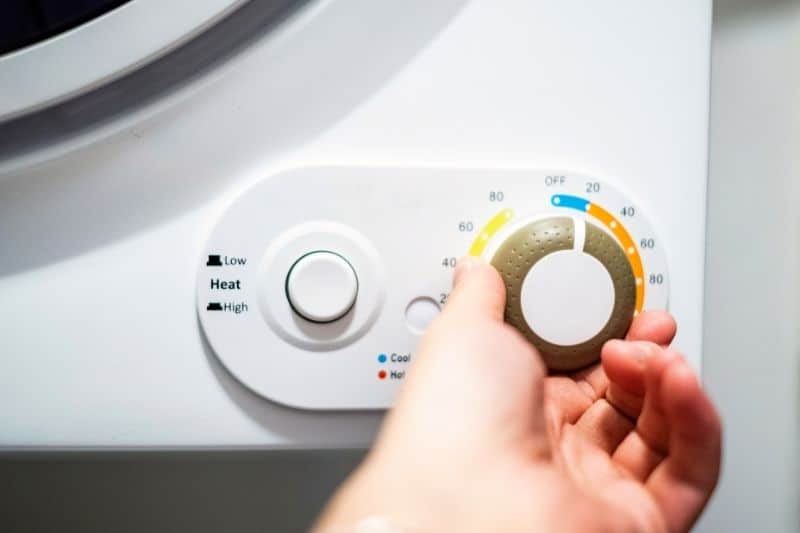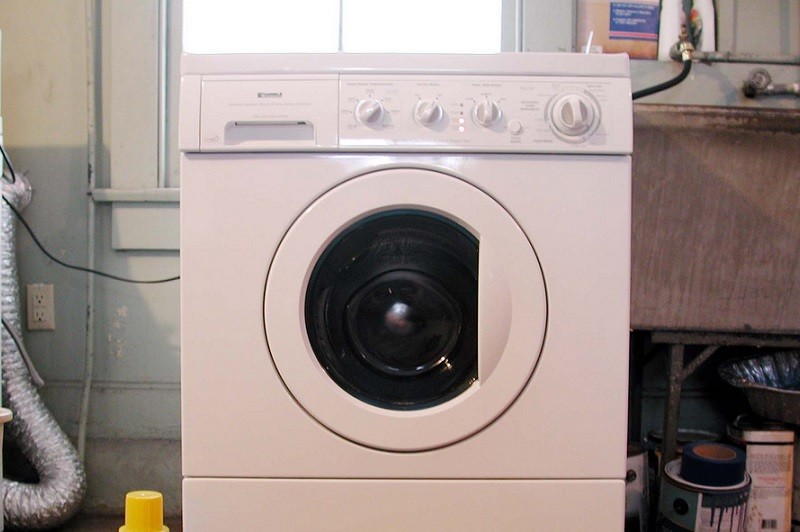Your tumble dryer has finished its cycle, and you’re going to take out your warm, dry clothes. When you open the dryer door, you’re instead greeted with a damp pair of jeans. You may as well have left your clothes out in the rain!
Here’s a list of possible reasons why your condenser dryer is leaving clothes damp:
- You over-filled the drum
- Your dryer is blocked with debris
- Your drying temperature is too low
- Your drying time is too short
- Your washing machine is leaving clothes too wet
- Your tumble dryer’s sensor dry function isn’t working
- Your tumble dryer’s heating element is faulty
I’ll now guide you through these causes in more detail, alongside some simple solutions to kick your condenser dryer back into gear. Let’s get those jeans dry!
1. You Over-Filled the Drum
Your condenser dryer has a load capacity for a reason. If the load exceeds the listed weight, the drum won’t have enough air circulation to dry fabric completely.
Your dryer will typically have its load capacity printed on the front, using kilograms as a measurement. Condenser dryers tend to have capacities between 7-10 kg, depending on the model.
Next time you use your dryer, try giving your laundry more room to breathe.
2. Your Dryer Is Blocked With Debris
If any part of your dryer is clogged with lint, it’s going to have trouble moving air through the machine.
Lint build-up within a tumble dryer is both inevitable and a severe fire hazard, so you’ll have to be mindful of this.

Clean the lint filter
The most obvious place to check for lint is the lint filter. Ideally, you should clean your dryer’s lint filter after each usage.
To clean the lint filter, remove it from the front of the drum. Open it up like a book and wipe away any lint with a damp cloth, or gently vacuum the lint out.
If there’s a massive amount of lint, run the filter under a tap in the opposite direction of the debris to dislodge it.
Finally, you need to let the filter dry before replacing it.
Clean inside the dryer
There could also be lint within other parts of the machine. You should check for lint within the condenser tray slot and the inside of the dryer.
Use your hands to pick out any fluff you see and use a dry cloth to wipe within the dryer.
You can also remove the condenser box from the dryer and rinse it in the sink to remove fluff. The condenser box is the part with a bendy vent tube attached to it. Make sure the condenser is dry before putting it back into your dryer.
If you can reach the pumps and hoses without a screwdriver, wipe them down with a dry cloth as well.
3. Your Drying Temperature Is Too Low
When you are setting the temperature for a drying cycle, be sure to consider the size and weight of the load and the density of the fabric.
If a load is heavy, like jeans or bed sheets, and comes out damp, it probably needs a higher heat setting to dry.
4. Your Drying Time Is Too Short

Alternatively, some fabric will need to dry for a longer duration on the same heat setting.
Be careful using high heat on laundry – it can cause some items, like towels, to tighten up and become scratchy.
5. Your Washing Machine Is Leaving Clothes Too Wet
If your clothes are coming out of the washing machine absolutely drenched, your tumble dryer won’t be able to dry them within the usual amount of time.
Check that your washing machine is removing enough excessive water from the fabric.
You may be overloading your washer, reducing air circulation, and causing it to retain too much water.
6. Your Tumble Dryer’s Sensor Dry Function Isn’t Working
Many condenser dryers come with a sensor dry function, which automatically senses the amount of moisture in your laundry and runs a cycle accordingly.
If the cycle has stopped and you’ve found damp clothes, the sensor is probably inaccurate. A faulty sensor could have several causes.
You put in a mixed load
If your load has both heavy and light fabrics, the heavier materials will migrate towards the back of the drum.
The sensor will notice the lighter fabrics at the front and end the cycle when it detects they’re dry. So, your dryer might end a cycle with dry t-shirts at the front and damp jeans at the back.
Don’t bundle mixed loads into your dryer, and instead group similar fabrics together.

You didn’t put enough clothes in the dryer
The sensor will not properly detect a load with only a few clothes, meaning that it’ll probably leave them damp.
If you’re using a sensor dry cycle, try to add in more clothes.
Your dryer’s moisture sensor needs cleaning
Over time, your dryer’s moisture sensor can become caked with dirt, blocking it from detecting moisture.
You can clean your moisture sensor by scrubbing it with some fine-grit sandpaper, then polishing the sensor with a dry cloth.
The sensor is generally at the front of the drum on new models and the back of the drum on older dryers.
Your dryer’s sensor is broken and needs to be replaced
If none of the above sensor solutions work for your sensor, it’s most likely broken.
Now would be a great time to use that manufacturer warranty, if you have one. Otherwise, it’s best to call a professional repair person to replace your machine’s sensor.
7. Your Tumble Dryer’s Heating Element Is Faulty
Tumble dryers use a heating element to create hot air. If the element isn’t warming the air, your clothes will stay damp in the dryer.
Test your heating element by running your dryer for around five minutes on a regular cycle. Then, open the door and check if the drum is warm. If you’ve got a cold drum, you’ll need to call a technician to fix the element!
Conclusion
If your clothes are still damp after using your condenser dryer, you may have over-filled your machine or set the temperature or timer too low.
If any part of your dryer is clogged with debris, it’ll obstruct the drying process. Your machine may have a broken part, such as a faulty heating element or sensor.
However, there are numerous possible causes for a condenser tumble dryer to be leaving clothes damp, and your dryer is going to be best diagnosed by a technician.

A recent uni graduate who likes writing, gaming, and drawing. I’m figuring out housekeeping tips alongside you while trying to provide eco-friendly cleaning options. Let’s find out how to use a tumble dryer together!






